In the US, politicians like Bernie Sanders or Alexandria Ocasio-Cortez inspire millions of people – although they represent classic social democratic politics and even use the word “socialism” in their speeches. The fact that the US is more than turbo-capitalism and apple pie is also shown by the strong civil society that organizes Americans for social movements like Black Lives Matter or #Metoo. An overview of US socialism history:
In Europe there is this image of the US as the land of capitalism, where people have to cling to the mendacious “American Dream”. The unrealistic dream that all citizens can make it from dishwasher to multimillionaire by just working hard enough.
But the U.S. was never just the land of capitalism and the super-rich, the land of Donald Trump, Bill Gates, Jeff Bezos and Mark Zuckerberg. In fact, there has always been a strong and also rebellious labor movement in the US that has strongly shaped the country throughout its history of socialism. Currently, the US socialists like Bernie Sanders or Alexandria Ocasio-Cortez are experiencing a revival and want to put capitalism on a leash.
– Advertisement –
Before 1900: The Dawn of US Socialism History
Socialism arrives in America in 1848. European and among them many Austrian and German refugees brought it with them as they fled from the European monarchies to America. The immigrants passed on their ideas of socialism and workers’ rights to the Americans. In 1876 the first socialist party in the United States, the “Workingmen’s Party of the United States”, was founded. It was founded even before many European socialist parties, such as the British Labour Party. Although this first Workingmen’s Party existed only briefly, it serves as a blueprint for a large number of socialist parties in America.
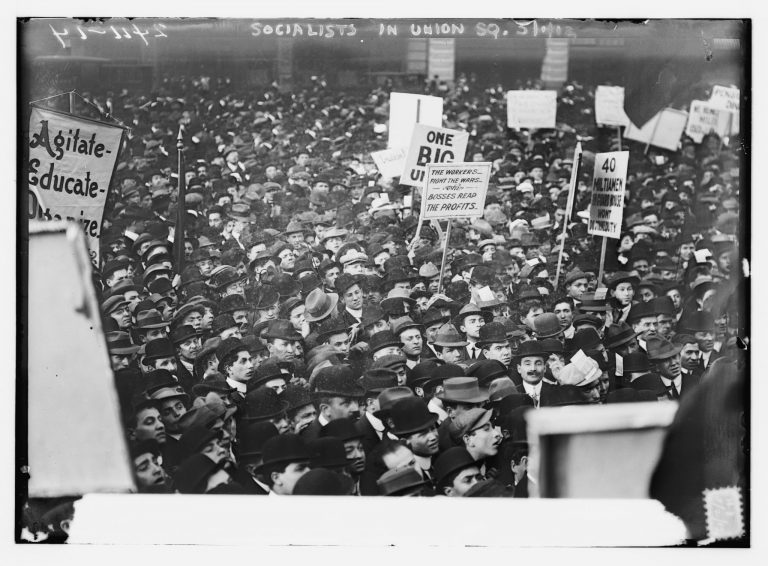
But why was there no large labor party in the US at that time as there was in Europe? The answer lies in the system of slavery. The American workers were divided into two groups: the poor white workers on the one hand and the black slaves who were forced to do brutal work in the cotton fields in the southern United States without pay. Considered property, black slaves were not allowed to make political demands or go on strike.
Civil War and the end of slavery
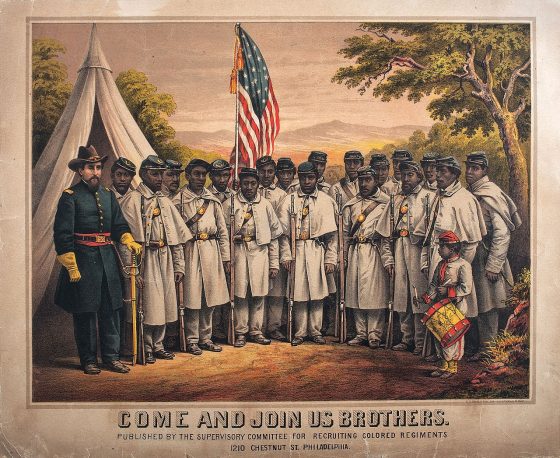
In 1861 Abraham Lincoln becomes US President. One of his goals was the abolition of slavery. The politicians of the southern states, on whose cotton fields a large part of the slaves worked, refused and split off from the US. In order to bring the secessionist Southern states, the Confederate states, back under the red-white-blue banner of the U.S. and to free the slaves in the South, Abraham Lincoln turned to weapons. The American Civil War began.
It would become an extremely violent civil war: more Americans died in the civil war than in any other war in which the US participated. In the fight against slavery, the Socialists of the United States inevitably sided with Abraham Lincoln. Many Socialists took part in battles against the Confederates: one, for example, was Joseph Weydemeyer, a socialist immigrant from Germany and a friend of Karl Marx and Friedrich Engels. He commanded an artillery regiment against the southern states.
After 4 years of war the fighting came to an end: the southern states had been militarily defeated. However, the Confederate leaders were able to keep their racist hatred of the black population alive. Although the slaves were freed, they were systematically excluded from elections. The Ku Klux Klan infiltrated police and politics and members of the clan killed innocent blacks in revenge for the lost civil war. Slavery was ended, but racism persisted.
Strikes define US Socialism History
When the civil war reached its conclusion, a wave of strikes and workers protests started across the United States. Working days were long, there was yet no 8-hour day and working conditions were poor. Employees often worked close together in factories, fire regulations were non-existent and child labor was common. The method of striking became increasingly popular among the workers. They stopped working and denied the bosses of the company any potential profits until their demands for fewer hours or more pay were met.
Socialists like the charismatic speaker Eugene V. Debs, who would later become head of the Socialist Party of America, organized these strikes. This was an unusual situation for the corporate bosses, since more workers’ rights meant fewer profits. The police, politicians and paid private detectives worked together on behalf of the capitalists to stop the strikes.
Socialism history – the hour of May 1st
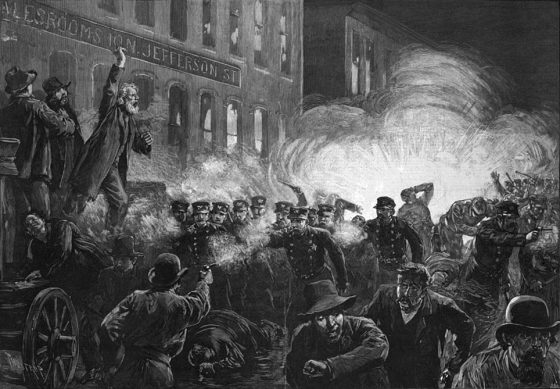
Our holiday, Labor Day on May 1, has its origin in one of those Strikes. On May 1, 1886, a several-day long strike began for the eight-hour day in Chicago. On the third day of the strike, the police killed six strikers and the next day the violence escalated even further when an unknown person threw a bomb at a group of policemen who fired back into the crowd. There were international expressions of solidarity and many countries, including Austria, later declared May 1 as Labor Day and thus a holiday. The growing violence of the police finally ended the wave of strikes. The United States’ entry into World War I was accompanied by the end of the mass strikes and the arrest of the head of the Socialist Party of America, Eugene V. Debs.
Stock market crash and economic crisis in the 30s
On Black Thursday in 1929, stock prices on Wall Street in New York collapsed. Millionaires became beggars, ordinary workers became unemployed in the ensuing “Great Depression”. Poverty and mass unemployment suddenly shaped the United States and many other countries of the world. 25% of Americans, about 15 million people, were unemployed, many people fell into alcoholism.
Socialism History: How the “New Deal” saved the US
With the rise of fascism in Europe, there was concern about democracy and social solidarity in the USA. And one President took action against the consequences of the economic crisis. The Democratic US President Franklin Delano Roosevelt, supported by socialist advisors, developed the “New Deal”. The “New Deal” was a well thought-out reform package to overcome the economic crisis and reduce social ills.
Minimum wages were introduced, Americans received unemployment and health insurance and a progressive tax system: the rich had to pay more taxes than the poor.

The term “New Deal” is a reference to shuffling the deck in card games. Franklin Delano Roosevelt reshuffled the cards in the USA. He introduced minimum wages , Americans received unemployment and health insurance and a progressive tax system. From then on, the rich had to pay more taxes than the poor. One of the main reasons why the economic crisis could be fought so effectively was that large-scale government construction projects created new jobs. Franklin Delano Roosevelt’s government invested 11 billion dollars in the construction of schools, hospitals and roads alone.
With the “New Deal” Roosevelt paved the way for a progressive social system for the USA and the USA felt a touch of social democracy with the “New Deal”. The economy boomed and the USA, as part of the Allies, was able to help defeat the Nazis in World War II.
Red Scare: Socialism becomes a “Red Danger”
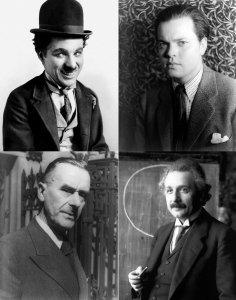
After the end of the Second World War, in 1945, the USA and the Soviet Union face each other in Berlin. Nazi Germany is defeated, Europe is in ruins. A new conflict overshadowed the reconstruction process: the Cold War. The USA wanted to prevent the expansion of Soviet communism at all costs and was also prepared to lead wars with high losses, such as the Korean War in 1950-1953, in order to stop the expansion of power of the former ally, the Soviet Union.
This also had repercussions in the USA itself; above all, a strong national panic was stirred up against the so-called “Red Danger”, the “Red Scare”. In the process, socialists of all forms were politically persecuted in the USA. A “Red” or “Soviet agent” was identified around every corner. Real and supposed socialists were publicly denounced and often lost their jobs as a result.
Pursued as Socialists: Charlie Chaplin and Albert Einstein
Famous personalities like the socialist and physicist Albert Einstein, the writer Thomas Mann (“The Magic Mountain”), the filmmaker Orson Welles (“Citizen Kane”) and the folk singer Pete Seeger were also victims of the Red Scare. Influential right-wing politicians also banned the actor Charlie Chaplin, known from films such as “The Great Dictator”, for alleged “communist sympathies”. Charlie Chaplin lived in Switzerland from then on. The Communist Party of the USA was even to be banned for a while.
In 1957 the mass panic of the “Red Scare” came to an end. The architect of the “Red Scare”, Senator Joseph McCarthy, accused high military officials of being communists. After the attack on the popular U.S. military, the Americans resented him and revealed how little truth the accusations had in fact. Slowly the “red scare” faded away, the zeitgeist changed. The paranoia had disappeared, but the “red scare” had nevertheless strongly influenced the public. Everything that had to do with socialism was labeled “evil”. The Democrats became more conservative and moved closer to the Republicans. Socialist ideas, however, survived at universities, in unions and in the civil rights movement.
Martin Luther King and the fight for Civil Rights in the US
1963 Martin Luther King gives his most famous speech – “I have a dream”. Several thousand people listen to King’s dream of a just America in front of the Lincoln Memorial in Washington. At that time, racial segregation still prevailed in the USA: the use of toilets and water dispensers was strictly separated according to skin color. Blacks had to ride in the rear, stuffy part of the buses because the front seats were reserved for white people. Racism influenced the lives of the black population on a daily basis. The civil rights movement fought against it.
Many of the leaders of the civil rights movement were socialists. The black civil rights activist Malcolm X was a socialist. The feminist Dorothy Day was a socialist. The Black Panther Party consisted of socialists. Martin Luther King was also a socialist, as well as Angela Davis. The civil rights movement demanded not only an end to racism but also more support for the unemployed and a minimum wage of the equivalent of 16 dollars per hour according to today’s calculations.
In comparison: in today’s USA it is the equivalent of 7 dollars. One year after King’s “I have a dream” speech in 1964, racial segregation was banned. But Martin Luther King’s dream of ending racism in the USA remains a dream today.
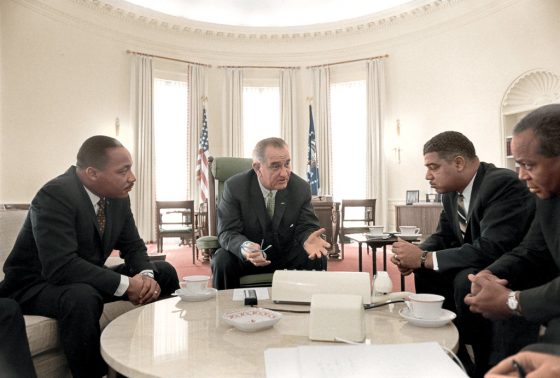
Neoliberalism triumphs in the US
Despite the civil rights movement, the U.S. political system shifted more and more to the right during the Cold War. Neoliberalism became popular in the USA. Neoliberalism means that companies should have a particularly large amount of freedom of action in the market, while avoiding state intervention wherever possible. The Republicans in particular pushed this new business-friendly economic form.
Basically, this meant:
- the social system was privatized
- The Americans now had to pay for visits to doctors and hospital stays themselves
- Taxes for the rich and companies fell drastically
- Deregulation, i.e. the dismantling of state regulations
The deregulation of the financial sector led to one economic crisis after another: the US savings bank crisis, the bursting of the dotcom bubble and the Great Recession were the consequences. The little man hardly benefited from this wave of privatizations and deregulations, making life for the average US citizen more difficult. A broken foot could now mean high debts for hospitalization. High tuition fees meant that some students were in debt for the rest of their lives. The deregulation wiped out the successes of the “New Deal”.
The Democrats drift to the right

With the inauguration of Republican Ronald Reagan as U.S. president in 1981, the Americans faced another wave of privatizations. But the Republicans did not push this destructive policy forward alone, the Democrats also participated: under President Bill Clinton, a Democrat, there were further cuts in the social system of the USA.
The socialists found themselves between the fronts. What should they do when both parties in the U.S., the Republicans and the Democrats, opposed social policies? During the “New Deal,” socialists had worked with the Democrats to defeat the Great Depression in the United States. After that, however, the Democrats drifted so far to the right that there was no room for socialist ideas within the Democrats (the Democratic Party).
Occupy Wall Street
In 2011, an event awakened in the socialism history in America: Occupy Wall Street. Out of nowhere, a huge wave of protests emerged. Wall Street, the center of the stock market, in New York was occupied. The reason for the protests, which lasted for weeks, was the ever-increasing gap between rich and poor. The rich were getting richer and richer, the poor poorer and poorer.
People had seen how the state had saved the banks with huge sums of money in the wake of the global financial crisis of 2008, but the people who had become unemployed as a result of the financial crisis received nothing. Demonstrators occupied Zuccotti Park in New York for several weeks. The protesters called for more equal opportunities and for an end to the unregulated financial speculation in the Wall Street stock market that had brought them so many crises.
Occupy Wall Street revived the US left: Socialists like David Graeber were at the forefront of the protests. The call for an end to unrestrained capitalism grew louder. For some, it was too loud. After over a month of protests, the end of Occupy Wall Street came in the form of pepper spray and police violence. Policemen cleared Zuccotti Park. Nevertheless, Occupy Wall Street’s call for more help for poor US citizens became more and more of a political mainstream. It paved the way for the success of a previously obscure senator from the state of Vermont.
History of socialism: Bernie Sanders changes everything
This senator from Vermont is Bernie Sanders. The Democratic Socialist Bernie Sanders is running as a possible Democratic presidential candidate in the pre-election campaign in 2016. Bernie Sanders’ demands are simple and are becoming increasingly popular:
- A public health system for all
- More control over powerful companies and their lobbies
- Stronger taxation of the rich
- Reduction of the enormous military expenditures
Bernie Sanders wants a new “New Deal” for the USA. Within a very short time an impressive mass movement of average Americans gathers behind him. The people are united above all by their dissatisfaction with the most pressing problems of the USA: poverty and racism.
Sanders himself is a veteran of US socialism history: he was a member of the Socialist Party of America, participated in demos of the civil rights movement, including the march on Washington, where Martin Luther King gave his famous “I have a dream” speech. He became mayor of Burlington and the Americans elected him to the House of Representatives and the U.S. Senate as a non-party member.
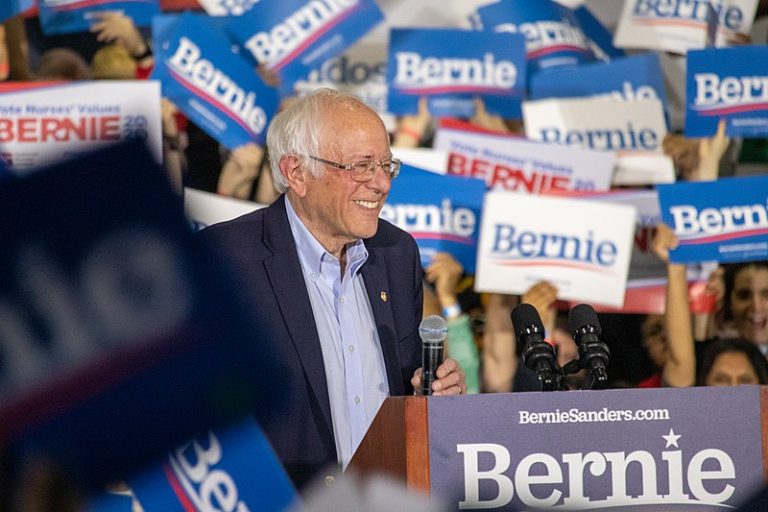
Sanders vs the Democratic Party establishment
In 2016 and 2020, however, he suffered setbacks: his attempts to become the Democratic presidential candidate failed. He lost to Hillary Clinton (2016) and Joe Biden (2020). Bernie Sanders’ defeats against Joe Biden and Hillary Clinton had a reason: he was fighting on “enemy” ground. As many Democrats had drifted strongly to the right since the “New Deal”, the party now contains of a neoliberal and a social wing.
Hillary Clinton outdid Bernie Sanders in the 2016 primaries. Clinton had the support of large sections of the Democratic Party establishment and the money and help of powerful business supporters. While Bernie Sanders stood on the shoulders of thousands of supporters, Hillary Clinton built her campaign on the support of the Democratic Party establishment. In the primaries for the Democratic presidential candidate, especially the superdelegates voted against Bernie Sanders, thus helping Hillary Clinton to victory. The superdelegates’ votes have a particularly high decision-making weight and who often come from the Democratic establishment. However, Clinton then lost miserably to right-wing populist Donald Trump.
Socialist Superstar: Alexandria Ocasio-Cortez
Despite the defeats, the movement around Bernie Sanders was able to bring several democratic socialists, such as Alexandria Ocasio-Cortez (“AOC”) and Ilhan Omar, to the House of Representatives. The campaigns of Alexandria Ocasio-Cortez now influence U.S. policy. Suddenly there is a dicussion about topics like a top tax rate of 70 percent for millionaires. Moreover, Alexandria Ocasio-Cortez’ Green New Deal is becoming an important issue and Amazon is not settling in New York after all.
Bernie Sanders showed that you don’t have to be ashamed of the word “socialism” and that you can become quite popular within social, socialist politics. Bernie Sanders and Alexandria Ocasio-Cortez inspired many young people, 62% of Americans between 18 and 34 see Sanders positively. He thus promoted the new social movement within and outside the Democratic Party.
Black lives matter
The next social wave of change in US socialism history began on May 25, 2020. The African-American George Floyd is murdered by a policeman because he was accused of using a forged banknote. The highly militarized police had been killing African-Americans for years. When a policeman murdered teenager Trayvon Martin in 2013, the protesters created the slogan “Black Lives Matter”.
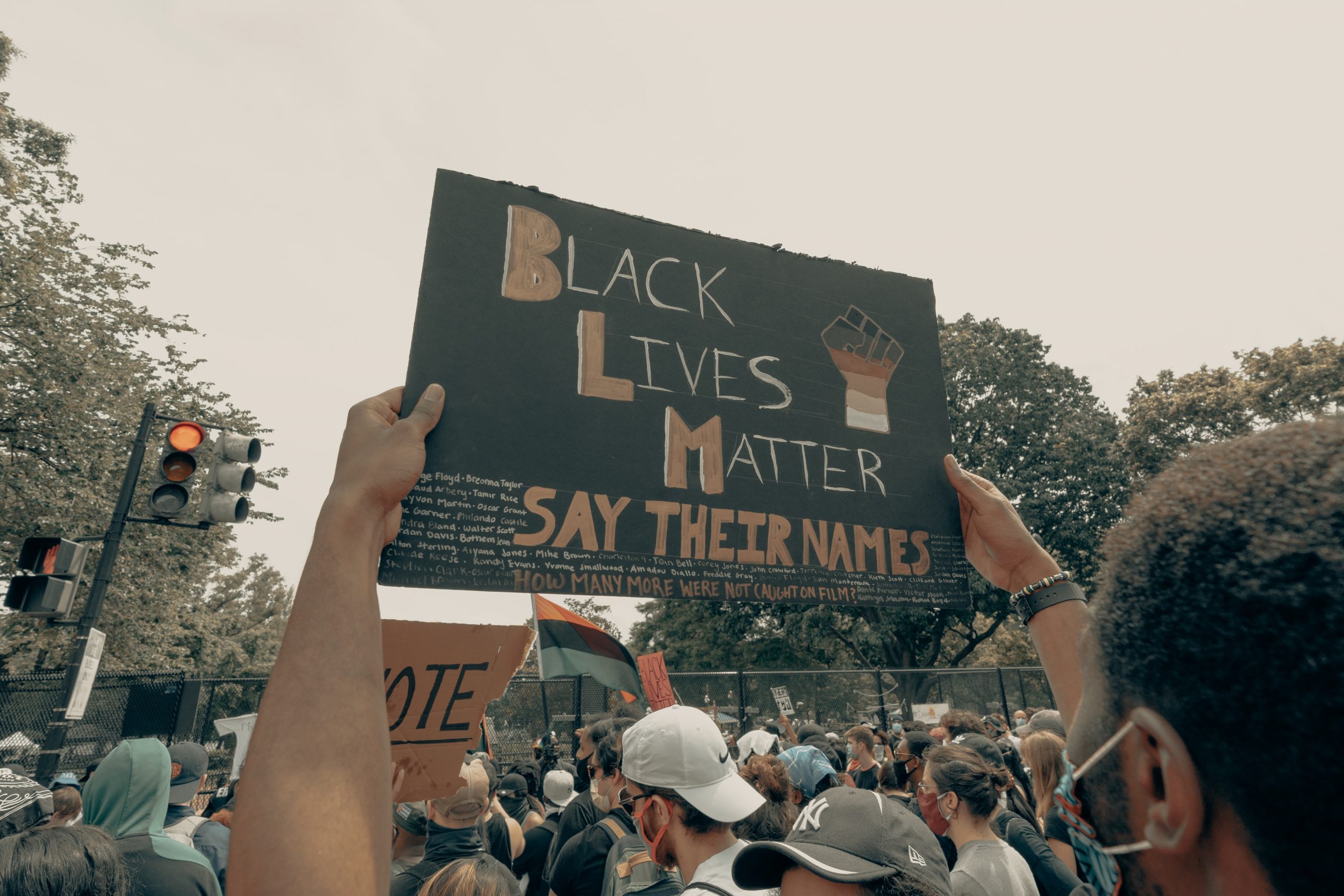
For many African-Americans, police violence is a daily danger; the probability that the police will kill an African-American is three times higher than for a white person. The killers usually get away with no punishment: only 1% of the police officers who killed a person face punishment. The video of the murder of George Floyd goes viral. Thousands of people took to the streets calling for an end to police violence and racism in the USA.
Instead of providing the police with more and more military equipment, the government should use the money to fund hospitals, schools and social housing. As so often in US history, the police responded to the protests with violence. President Trump called the demonstrators criminals and terrorists and called for the deployment of the National Guard. But the protests continued and spread all over the world. Even though the media is reporting less and less about the Black-lives-matter protests in the USA, they still continue. Many Americans have had enough of poverty, racism and police violence. They want to change the USA as we know it.
The rights to the content remain with the original publisher.
#American #Apple #Pie